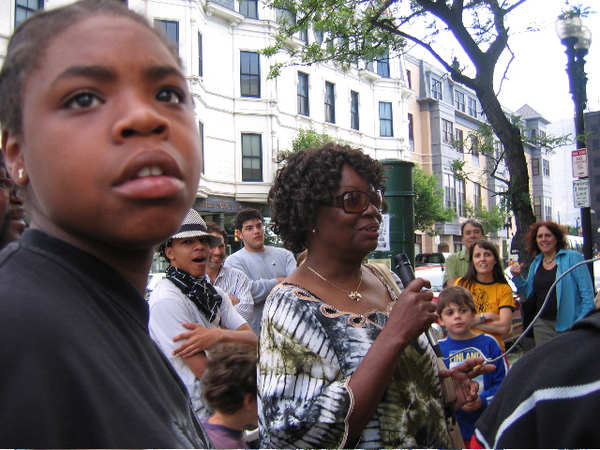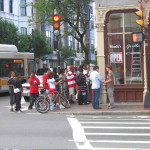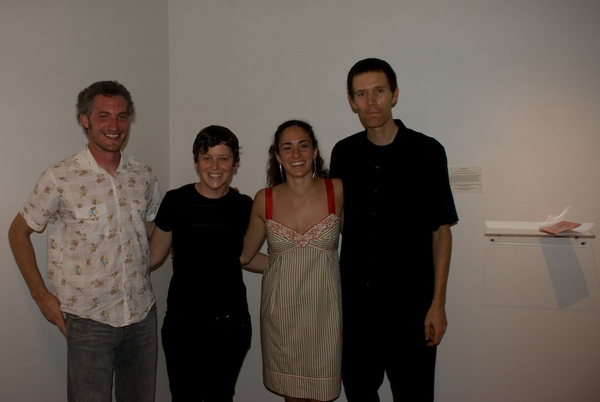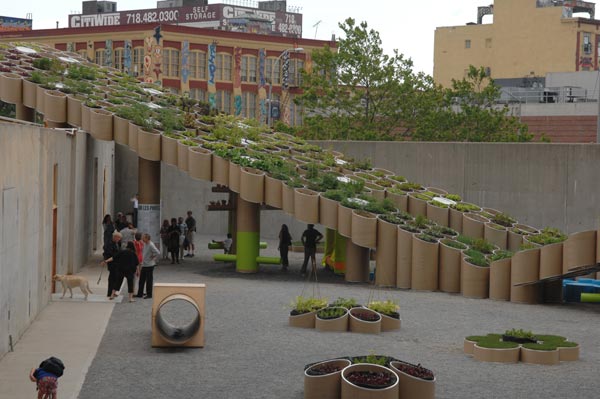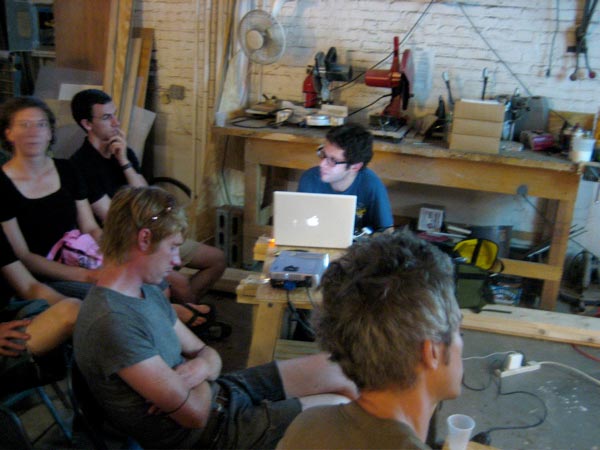JOHN EWING'S VIRTUAL STREET CORNERS
Dudley Square in Roxbury and Coolidge Corner in Brookline are close geographically, but demographically they seem disparate. For about a week in June, artist John Ewing tried to change that.
In his “Virtual Street Corners” exhibit, Ewing, a New York State native now living in Mission Hill, sought to link Dudley Square and Coolidge Corner through videoconferencing technology. Passers-by in both neighborhoods could communicate with each other through microphones and video screens. Underlying the project were subtexts of race, income, and ethnic tensions in Boston history.
“I felt in Boston there was very little crossover between neighborhoods,” Ewing said. “People never traveled. It feels Boston is very much broken down into neighborhoods, mostly segregated.”
He said that in the last census, the population of Dudley Square was less than five percent white, while only ten percent of Coolidge Corner residents were African-American.
Imagining chat sessions on city sidewalks
Officially, “Virtual Street Corners” ran from June 14-21, with videoconferencing locations at Stash’s Grille in Dudley Square and Brookline Booksmith in Coolidge Corner. Residents of Roxbury and Brookline had a chance to converse through technology.
The project was conceived by Ewing, an Ithaca native who moved to El Salvador in 1995 to work as an artist for a human rights organization. He relocated to the Boston area in 1997, living in both Jamaica Plain and Mission Hill.
Ewing’s original idea for the project was to link the Israeli city of Tel Aviv, the Palestinian city of Ramallah, and New York City, but tensions in Ramallah prevented this from happening. Ewing decided to change the setting to the local level, which would give him more control.
Two years ago, Ewing received a grant from the Berwick Research Institute that helped get him started. He said that Boston city councilor Chuck Turner was “very supportive,” writing letters of recommendation.
Finding locations and technology for the Roxbury site proved a challenge. “I approached business owners who were willing to support it, but outside landlords refused,” Ewing said. “They couldn’t control what people would say, and the groups of people congregating outside.” He added, “It was difficult logistically to do things in Dudley. Comcast won’t service the entire Dudley area. That was a shock – an urban neighborhood very close to downtown.” And, he said, “Verizon’s speeds are so low” that he decided to get high-speed Internet service from a small group in Seattle.
“Coolidge Corner was much easier,” he said. “Coolidge Corner has more local business owners who have more control over what they say. In Dudley, the owners are from outside of the community. They weren’t willing to take risks. It was a little bit hard to explain the concept. It’s not like painting or established art.”
Closeness and distance
Interactions between the neighborhoods seem rare, according to literature from the exhibit. “Dudley Square and Coolidge Corner are just 2.4 miles apart – a 15 minute ride on the 66 bus,” a leaflet reads. “Yet, few from each neighborhood appear to visit the other. Why is this?”
As part of the project, Ewing interviewed 25 people in each neighborhood near the 66 bus stop, asking them to map out their daily travels. He displayed these routes in a leaflet. “Route 9 was a line people didn’t cross,” Ewing said. “In Coolidge Corner, people went to Cambridge, downtown, and west towards Newton. In Dudley Square, very few people went to Cambridge and Brookline.”
The art project encouraged passers-by to ask questions of their counterparts on the video screen. “Start with easy questions,” the leaflet advised, including “When was the last time they traveled to your neighborhood?”, “How has Boston/Brookline changed over their lifetime?”, and “How does Boston’s history still affect (sp) us?”
Ewing addressed the disruptions in Boston in the 1970s that affected both Brookline and Roxbury. “The Dudley area used to be a Jewish area,” he said. “Interviewing people about the project, I got stories from elders who had been on Dudley Street and moved to Brookline. I did research on the Internet. There was a history of red-lining on Blue Hill Avenue and different areas. Real estate companies and banks had red-lining districts, many of which were Jewish, and were purposely bringing in African-Americans, limiting African-American purchasing ability. There was white flight. I haven’t done a lot of research.”
Days of dialogue
A visit to both sites showed the ability of the exhibit to attract pedestrians’ attention. Passers-by stopped to peer into the screens. “I think it’s pretty good,” said Ricardo Royal of Randolph, who had come with his father, Edward, to visit Spinale’s Sub Shop, next door to Stash’s Grille. “It’s like the unification of the neighborhoods, coming together for the common good.”
Outside Brookline Booksmith, Ewing and his assistant, Minotte Romulus of Dorchester, were disassembling the exhibit after the scheduled closing date. “I think it went pretty well,” Romulus said. “There weren’t any problems, nobody swearing.” She added, “I just hope the two neighborhoods come together. I don’t know why there’s a lot of segregation in our community.”
Ewing’s assessment was positive. “One fear was that with a TV in the window, people would pass by and not engage,” he said. “I realized people would have a little bit of difficulty comprehending the live connection, that it was not just advertising in the window.” However, he said, “I was surprised by how eager people are to participate.” He added, “There was a lot of talk about race relations in Boston and the history of it … There was a little bit of suspicion on both sides on why there weren’t more people wanting to talk (on the other side) and just kind of wondering how far it will go.”
How far will it go? One development of the project, Ewing said, is that Turner and Hillel Levine, who profiled white flight from inner-city Boston in The Death of an American Jewish Community, tried to discuss practical ways to continue connecting Dudley Square and Coolidge Corner. These included free bus service and different incentives for people to visit their counterpart community once a month. It seems that these talks will continue. And, Ewing said, “I’d love to follow up … There are a lot of ways you can use technology.”
- Images of the public participating in John Ewing’s Virtual Street Corners.
John Ewing's Virtual Street Corners
"Virtual Street Corners" was on view June 12 - June 21, 2008, with the "opening" on June 18, at Stash's Grille in Roxbury and Brookline Booksmith in Brookline.
All images are courtesy of the artist.

